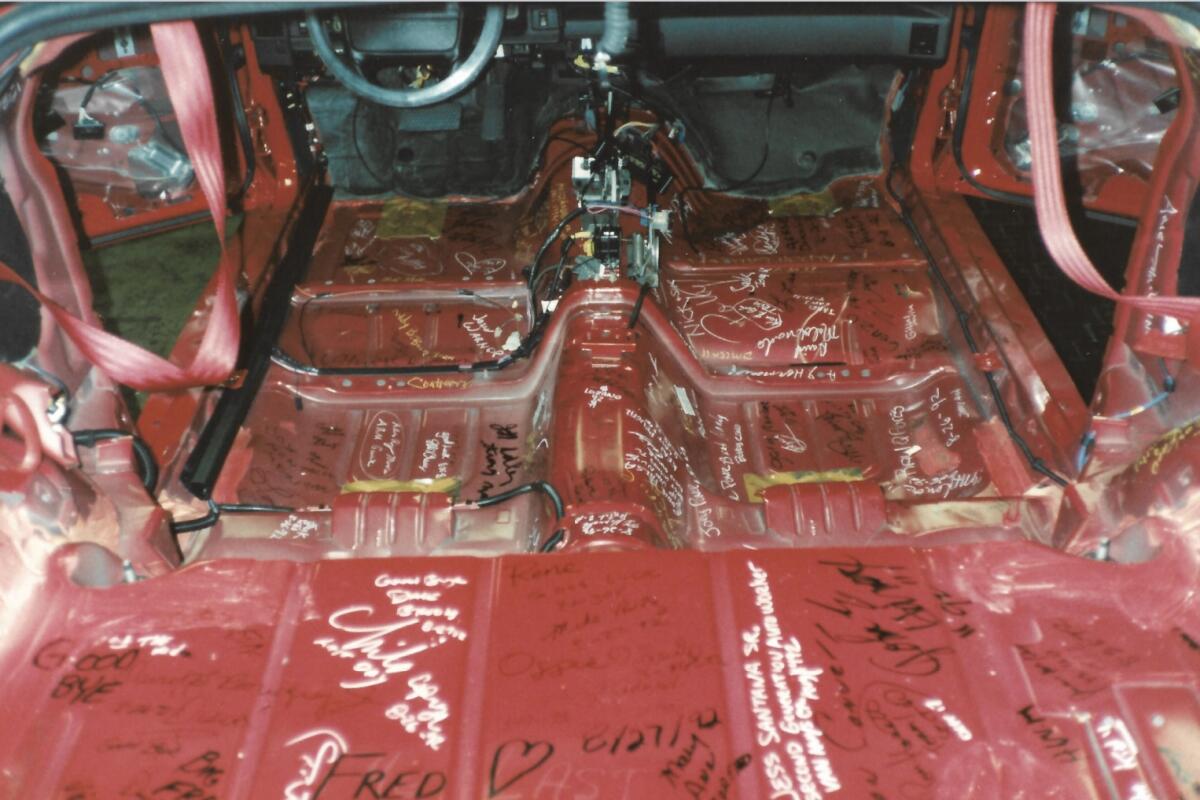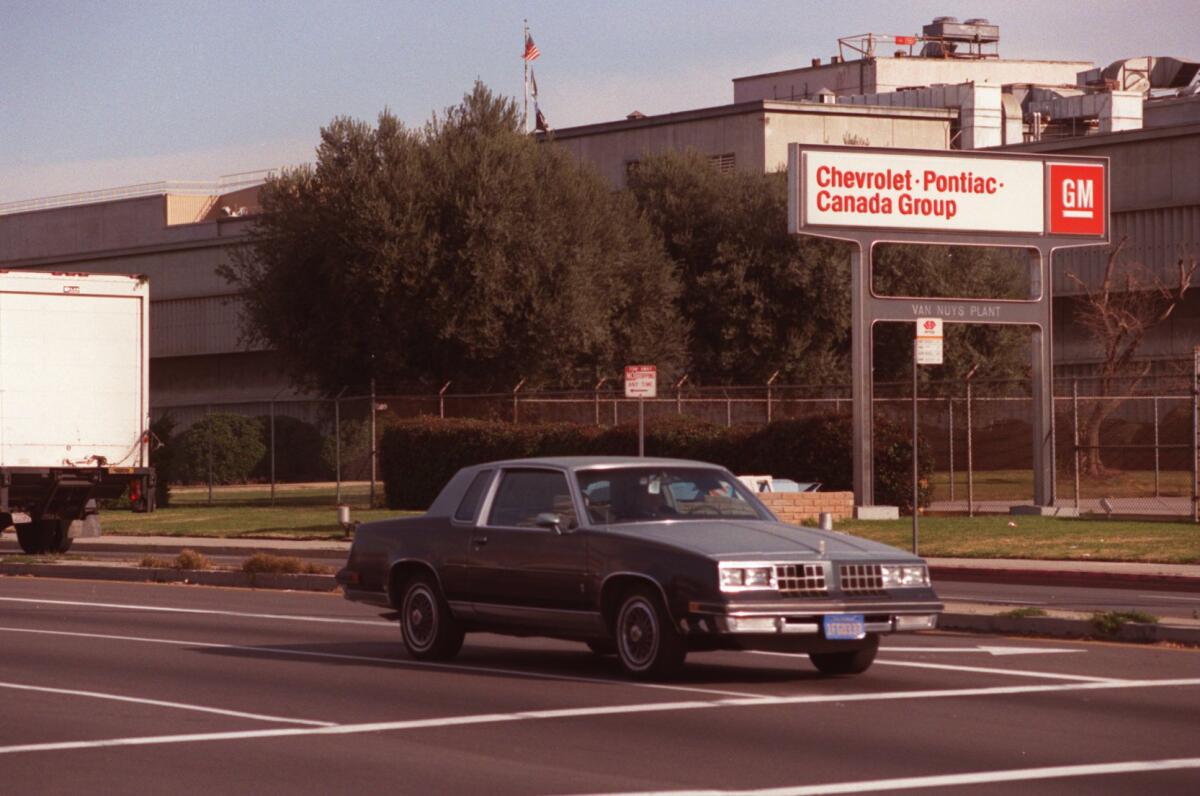Op-Ed: When Camaros and Firebirds roamed the San Fernando Valley

Improbably, the best monument to the old General Motors assembly plant in Van Nuys that closed 30 years ago this week sits in a garage in Jamestown, N.D. It’s the last car produced at a facility that in 44 years of operation manufactured 6.3 million automobiles and employed thousands in the San Fernando Valley.
The red 1992 Chevrolet Camaro Z-28 with Heritage black racing stripes is owned by an enthusiast named Leonard Stevenson, who has lovingly maintained it ever since he watched it roll off the production line on Aug. 26, 1992. Three decades later, his “Last Camaro” is a symbol of a vanished era of labor and a tribute to a way of life in the mid-20th century San Fernando Valley that has all but disappeared.
When the GM plant opened in 1947, the Valley was experiencing a period of rapid expansion — transforming from an agricultural outskirt of Los Angeles into a thrumming hub of industry to meet the ambitions of postwar America. High-paying union manufacturing and production jobs from GM and other companies, coupled with the cheap cost of land for housing and the opening of a major transportation artery — the Ventura Freeway — in 1960, put the peripheral L.A. suburb on the map.

The blue-collar boom, however, started going bust in the early ‘80s. Los Angeles continued expanding and the cost of living rose. At the GM plant, there were layoffs and temporary closures, leading to picketing by workers represented by United Auto Workers Local 645.
Finally, in 1989, GM announced plans to relocate Camaro and Firebird production to a new facility in Quebec. Employees hoped the company would keep the Van Nuys plant operating; it still produced 406 cars per day. But by 1992, GM was no longer willing to bear the cost of assembling any cars in Southern California, and union power was on the wane nationwide. Time had run out for UAW Local 645. Some 2,600 workers were employed at the Van Nuys plant when it shuttered.
Stevenson, living in Iowa, read the news of the plant closure. He’d already owned two vintage Camaros. He decided he would buy the last car produced at Van Nuys as it rolled off the assembly line. It was an outlandish idea, but Stevenson knew it was possible. In 1987, another GM customer had been allowed to walk the assembly line at the Pontiac, Mich., plant to purchase the last Buick Grand National. After a letter-writing campaign, Stevenson convinced GM executives to let him do the same.
At 5:30 a.m. on Aug. 26, Stevenson was led by a plant executive through the huge facility to the assembly line until they reached the final car — the Z-28, its body already coated in a cherry-glossed red.
Unsurprisingly, the mood at the plant that day was gloomy. The average length of service for Van Nuys plant employees was 20 years and the average wage was $17 an hour — about $35 in 2022 dollars. Some workers donned protest T-shirts — “GM Sucks,” “UAW Local 645—‘Unemployed’ Auto Workers” — as they stood witness to the end of an era.
“What is the American Dream now? Now they’re moving on and leaving everybody in the dust,” Ed Johnsen, a 16 year employee of the plant, told a reporter then. He had met his wife, Patti, on the job.
As the last Camaro rolled along the line, the workers put their signature on the component they installed. They wanted their names on the last car they’d ever build. After the workers down the line signed the car, they turned in their badges and clocked out for the final time.
That evening, word spread about signing the car, and by the time Stevenson returned the following morning for the completion of the assembly, he was greeted by many autoworkers who had rushed back onto the floor to get a chance to put their own mark on the car. The drive shaft, the door panels, the transmission, the rear axle — all of it was signed. Painters left their marks too, under the seat in silver paint, sealed in clear coat.
Overall, Stevenson estimates that more than 2,000 people signed his Camaro. In the weeks that followed, workers sent him newspaper articles about the plant closure and photos of his visit. They wanted the last car to be a memento of what that plant had meant to them and their community.
The auto industry’s departure marked the beginning of the end of the Valley as a labor town. Automotive plants in Pico Rivera, South Gate and Commerce had all closed over the prior two decades; the Van Nuys plant was the last facility standing.
Today, the Valley retains some of its outsider status in personality, but with the exception of the film and television industry, those old union jobs, which created working-class prosperity, have vanished. The median home price in the San Fernando Valley in 2022 is $901,500, out of reach for blue-collar workers.
But for the autoworkers of Van Nuys, connections to the GM plant still linger. They live all over the country and have a 500-plus-member Facebook group. They occasionally attend in-person reunions and distribute commemorative T-shirts to keep memories of their old plant alive.
It’s fitting that the Last Camaro’s license plate is inscribed in their honor: 4UAW645.
Andrew Warren is a co-host of “818s & Heartbreak,” a podcast about the San Fernando Valley. Tim Moore works in automotive media and is a second-generation Chevrolet Camaro enthusiast. This article was produced in partnership with Zócalo Public Square.
More to Read
A cure for the common opinion
Get thought-provoking perspectives with our weekly newsletter.
You may occasionally receive promotional content from the Los Angeles Times.










